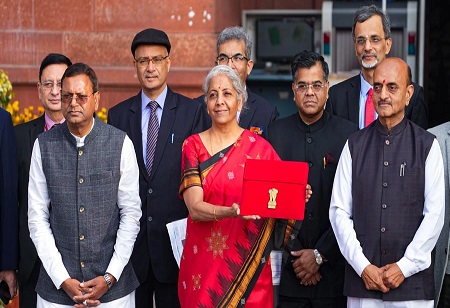Finance minister Nirmala Sitharaman started this year’s budget speech by naming the accomplishments of the government. She hailed the achievements in the areas of digital public infrastructure, Covid vaccination, climate related goals and more. Contrary to the expectations of the
budget 2023 being a populist one owing to the upcoming Lok Sabha elections in 2024, she made it evident from the very beginning that the government’s focus was on accelerating the
economic growth.
With sharp focus on infrastructure and investment, the budget is likely to give a fillip to growth and employment. At the same time, policies aimed at enabling environmentally sustainable growth will bring the country closer to achieving the set goal of reducing Emissions Intensity of the GDP by 45 percent by 2030. Without ruling out the budget’s benefits to any industrial sector, let us have a look at those which are liable to profit the most.
Agriculture: Boosting Accessibility and Inclusion
India's agriculture is an important sector in the Indian economy. Half of rural households rely on agriculture for their livelihoods as well. The industry amounts to almost 19% of GDP and it provides employment for more than 45% of the population. Infrastructural renovations in the road, power generation, knowledge transfer and reforms are the main reasons for the growth of the agricultural productivity in India.
Nevertheless, India has made massive productivity gains in plant yields recently, but they are far from the optimal 30 to 60 percent of what can be achieved on farms of developed and other developing countries. Additionally, the increase in agricultural productivity does not completely eliminate the food losses due to the inefficient infrastructure and the frequent disorder in the retail trade in India, which is among the worst in the whole world.
To solve the existing challenges in the agriculture sector, finance minister introduced several commendable reforms. She proposed for a digital public infrastructure to be built which will be accessible, inclusive and informative solution for farmers.
“Digital public infrastructure for agriculture will be built as an open source, open standard and inter operable public good. This will enable inclusive, farmer-centric solutions through relevant information services for crop planning and health, improved access to farm inputs, credit, and insurance, help for crop estimation, market intelligence, and support for growth of agri-tech industry and start-ups,” she said in her budget speech.
The agricultural credit target is going to be increased to Rs 20 lakh crore which will be aimed at animal husbandry, dairy, and fisheries sector. Moreover, an Agriculture Accelerator Fund is going to be set-up to support agri-startups founded by young entrepreneurs in rural areas.
The focus will be on bringing innovative and affordable solutions for challenges faced by farmers. In addition, an Atmanirbhar Clean Plant Program will be launched to enhance availability of disease-free, quality planting material for high value horticultural crops. The program will materialize at an outlay of Rs 2,200 crore.
